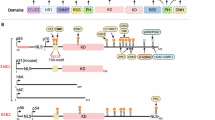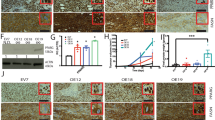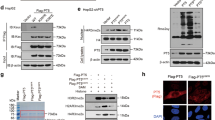Abstract
Large tumour suppressor (LATS) 1/2, the core kinases of Hippo signalling, are critical for maintaining tissue homeostasis. Here, we investigate the role of SUMOylation in the regulation of LATS activation. High cell density induces the expression of components of the SUMOylation machinery and enhances the SUMOylation and activation of Lats1 but not Lats2, whereas genetic deletion of the SUMOylation E2 ligase, Ubc9, abolishes this Lats1 activation. Moreover, SUMOylation occurs at the K830 (mouse K829) residue to activate LATS1 and depends on the PIAS1/2 E3 ligase. Whereas the K830 deSUMOylation mutation of LATS1 found in the human metastatic prostate cancers eliminates the kinase activity by attenuating the formation of the phospho-MOB1/phospho-LATS1 complex. As a result, the LATS1(K830R) transgene phenocopies Yap transgene to cause the oversized livers in mice, whereas Lats1(K829R) knock-in phenocopies the deletion of Lats1 in causing the reproductive and endocrine defects and ovary tumours in mice. Thus, SUMOylation-mediated LATS1 activation is an integral component of Hippo signalling in the regulation of tissues homeostasis.
This is a preview of subscription content, access via your institution
Access options
Subscribe to this journal
Receive 50 print issues and online access
$259.00 per year
only $5.18 per issue
Buy this article
- Purchase on Springer Link
- Instant access to full article PDF
Prices may be subject to local taxes which are calculated during checkout







Similar content being viewed by others
References
Meng Z, Moroishi T, Guan KL. Mechanisms of Hippo pathway regulation. Genes Dev. 2016;30:1–17. https://doi.org/10.1101/gad.274027.115
Yu FX, Zhao B, Guan KL. Hippo pathway in organ size control, tissue homeostasis, and cancer. Cell. 2015;163:811–28. https://doi.org/10.1016/j.cell.2015.10.044
John M, Tao WF, Fei XL, Fukumoto R, Carcangiu ML, Brownstein DG, et al. Mice deficient of Lats1 develop soft-tissue sarcomas, ovarian tumours and pituitary dysfunction. Nat Genet. 1999;21:182–6. https://doi.org/10.1038/5965
Pantalacci S, Tapon N, Léopold P. The Salvador partner Hippo promotes apoptosis and cell-cycle exit in Drosophila. Nat Cell Biol. 2003;5:921–7. https://doi.org/10.1038/ncb1051
Moroishi T, Hansen CG, Guan KL. The emerging roles of YAP and TAZ in cancer. Nat Rev Cancer. 2015;15:73–9. https://doi.org/10.1038/nrc3876
Moroishi T, Park HW, Qin B, Chen Q, Meng Z, Plouffe SW, et al. A YAP/TAZ-induced feedback mechanism regulates Hippo pathway homeostasis. Genes Dev. 2015;29:1271–84. https://doi.org/10.1101/gad.262816.115
Dong JX, Feldmann G, Huang JB, Wu S, Zhang NL, Comerford SA, et al. Elucidation of a universal size-control mechanism in Drosophila and mammals. Cell. 2007;130:1120–33. https://doi.org/10.1016/j.cell.2007.07.019
Camargo FD, Gokhale S, Johnnidis JB, Fu D, Bell GW, Jaenisch R, et al. YAP1 increases organ size and expands undifferentiated progenitor cells. Curr Biol. 2007;17:2054–60. https://doi.org/10.1016/j.cub.2007.10.039
Hay RT. SUMO: a history of modification. Mol Cell. 2005;18:1–12. https://doi.org/10.1016/j.molcel.2005.03.012
Gareau JR, Lima CD. The SUMO pathway: emerging mechanisms that shape specificity, conjugation and recognition. Nat Rev Mol Cell Biol. 2010;11:861–71. https://doi.org/10.1038/nrm3011
Seeler JS, Dejean A. SUMO and the robustness of cancer. Nat Rev Cancer. 2017;17:184–97. https://doi.org/10.1038/nrc.2016.143
Galanty Y, Belotserkovskaya R, Coates J, Polo S, Miller KM, Jackson SP. Mammalian SUMO E3-ligases PIAS1 and PIAS4 promote responses to DNA double-strand breaks. Nature. 2009;462:935–9. https://doi.org/10.1038/nature08657
Yagil Z, Nechushtan H, Kay G, Yang CM, Kemeny DM, Razin E. The enigma of the role of protein inhibitor of activated STAT3 (PIAS3) in the immune response. Trends Immunol. 2010;31:199–204. https://doi.org/10.1016/j.it.2010.01.005
Schimmel J, Eifler K, Sigurðsson JO, Cuijpers SA, Hendriks IA, Verlaan-de Vries M, et al. Uncovering SUMOylation dynamics during cell-cycle progression reveals FoxM1 as a key mitotic SUMO target protein. Mol cell. 2014;53:1053–66. https://doi.org/10.1016/j.molcel.2014.02.001
Eifler K, Vertegaal AC. SUMOylation-mediated regulation of cell cycle progression and cancer. Trends Biochem Sci. 2015;40:779–93. https://doi.org/10.1016/j.tibs.2015.09.006
Flotho A, Melchior F. Sumoylation: a regulatory protein modification in health and disease. Ann Rev Biochem 2013;82:357–85. https://doi.org/10.1146/annurev-biochem-061909-093311
Mei L, Yuan LW, Shi W, Fan SH, Tang C, Fan XY, et al. SUMOylation of large tumor suppressor 1 at Lys751 attenuates its kinase activity and tumor-suppressor functions. Cancer Lett. 2017;386:1–11. https://doi.org/10.1016/j.canlet.2016.11.009
Lu L, Li Y, Kim SM, Bossuyt W, Liu P, Qiu Q, et al. Hippo signaling is a potent in vivo growth and tumor suppressor pathway in the mammalian liver. Proc Natl Acad Sci USA 2010;107:1437–42. https://doi.org/10.1073/pnas.0911427107
Yi J, Lu L, Yanger K, Wang W, Sohn BH, Stanger BZ, et al. Large tumor suppressor homologs 1 and 2 regulate mouse liver progenitor cell proliferation and maturation through antagonism of the coactivators YAP and TAZ. Hepatology. 2016;64:1757–72. https://doi.org/10.1002/hep.28768
Nacerddine K, Lehembre F, Bhaumik M, Artus J, Cohen-Tanoudji M, Babinet C, et al. The SUMO pathway is essential for nuclear integrity and chromosome segregation in mice. Dev Cell. 2005;9:769–79. https://doi.org/10.1016/j.devcel.2005.10.007
Yu EY, Coleman R, Schultz N, Fang M, Lange PH, Shendure J, et al. Substantial interindividual and limited intraindividual genomic diversity among tumors from men with metastatic prostate cancer. Nat Med. 2016;22:369–78. https://doi.org/10.1038/nm.4053
Li W, Cooper J, Zhou L, Yang CY, Erdjument-Bromage H, Zagzag D. Merlin/NF2 loss-driven tumorigenesis linked to CRL4(DCAF1)-mediated inhibition of the hippo pathway kinases Lats1 and 2 in the nucleus. Cancer Cell. 2014;26:48–60. https://doi.org/10.1016/j.ccr.2014.05.001
Pefani DE, Latusek R, Pires I, Grawenda AM, Yee KS, Hamilton G, et al. RASSF1A-LATS1 signalling stabilizes replication forks by restricting CDK2-mediated phosphorylation of BRCA2. Nat Cell Biol. 2014;16:962–71. https://doi.org/10.1038/ncb3035. 1-8
Kim M, Kim M, Park SJ, Lee C, Lim DS. Role of Angiomotin-like 2 mono-ubiquitination on YAP inhibition. EMBO Rep. 2016;17:64–78. https://doi.org/10.15252/embr.201540809
Si Y, Ji X, Cao X, Dai X, Xu L, Zhao H, et al. Src inhibits the hippo tumor suppressor pathway through tyrosine phosphorylation of Lats1. Cancer Res. 2017;77:4868–80. https://doi.org/10.1158/0008-5472.CAN-17-0391
Zhang Q, Du X, He Q, Shi W, Mei L, Qv M, et al. T851I mutation of human large tumor suppressor 1 disrupts its kinase activity and tumor-suppressor functions. Life Sci. 2021;264:118655 https://doi.org/10.1016/j.lfs.2020.118655
Yang X, Li DM, Chen W, Xu T. Human homologue of Drosophila lats, LATS1, negatively regulate growth by inducing G(2)/M arrest or apoptosis. Oncogene. 2001;20:6516–23. https://doi.org/10.1038/sj.onc.1204817
Lapi E, Di Agostino SD, Donzelli S, Gal H, Domany E, Rechavi G, et al. PML, YAP, and p73 are components of a proapoptotic autoregulatory feedback loop. Mol Cell. 2008;32:803–14. https://doi.org/10.1016/j.molcel.2008.11.019
Yan Y, Ollila S, Wong IP, Vallenius T, Palvimo JJ, et al. SUMOylation of AMPKα1 by PIAS4 specifically regulates mTORC1 signalling. Nat Commun. 2015;6:8979 https://doi.org/10.1038/ncomms9979
Rubio T, Vernia S, Sanz P. Sumoylation of AMPKb2 subunit enhances AMPactivated protein kinase activity. Mol Biol Cell. 2013;24:1801–11. https://doi.org/10.1091/mbc.E12-11-0806
Ritho J, Arold ST, Yeh ET. A critical SUMO1 modification of LKB1 regulates AMPK activity during energy stress. Cell Rep. 2015;12:734–42. https://doi.org/10.1016/j.celrep.2015.07.002
Wang XD, Gong Y, Chen ZL, Gong BN, Xie JJ, Zhong CQ. TCR- induced sumoylation of the kinase PKC-q controls T cell synapse organization and T cell activation. Nat Immunol. 2015;16:1195–203. https://doi.org/10.1038/ni.3259
Li R, Wei J, Jiang C, Liu DM, Deng L, Zhang K, et al. Akt SUMOylation regulates cell proliferation and tumorigenesis. Cancer Res. 2013;73:5742–53. https://doi.org/10.1158/0008-5472.CAN-13-0538
Aukrust I, Bjorkhaug L, Negahdar M, Molnes J, Johansson BB, Müller Y, et al. SUMOylation of pancreatic glucokinase regulates its cellular stability and activity. J Biol Chem. 2013;288:5951–62. https://doi.org/10.1074/jbc.M112.393769
Tao W, Zhang S, Turenchalk GS, Stewart RA, St John MA, Chen W, et al. Human homologue of the Drosophila melanogaster lats tumour suppressor modulates CDC2 activity. Nat Genet. 1999;21:177–81. https://doi.org/10.1038/5960
Tang F, Gao R, Jeevan-Raj B, Wyss CB, Kalathur RKR, Piscuoglio S, et al. LATS1 but not LATS2 represses autophagy by a kinase-independent scaffold function. Nat Commun 2019;10:5755 https://doi.org/10.1038/s41467-019-13591-7
Rabellino A, Andreani C, Scaglioni PP. The role of PIAS SUMO E3-ligases in cancer. Cancer Res. 2017;77:1542–7. https://doi.org/10.1158/0008-5472.CAN-16-2958
Severgnini M, Sherman J, Sehgal A, Jayaprakash NK, Aubin J, Wang G, et al. A rapid two-step method for isolation of functional primary mouse hepatocytes: cell characterization and asialoglycoprotein receptor based assay development. Cytotechnology. 2012;64:187–95. https://doi.org/10.1007/s10616-011-9407-0
Liu NH, Mei L, Fan XY, Tang C, Ji X, Hu XH, et al. Phosphodiesterase 5/protein kinase G signal governs stemness of prostate cancer stem cells through Hippo pathway. Cancer Lett. 2016;378:38–50. https://doi.org/10.1016/j.canlet.2016.05.010
Wu X, Tu X, Joeng KS, Hilton MJ, Williams DA, Long F. Rac1 activation controls nuclear localization of beta-catenin during canonical Wnt signaling. Cell. 2008;133:340–53. https://doi.org/10.1016/j.cell.2008.01.052
Eswar N, Eramian D, Webb B, Shen MY, Sali A. Protein structure modeling with MODELLER. Methods Mol Biol. 2008;426:145–59. https://doi.org/10.1007/978-1-60327-058-8_8
Webb B, Sali A. Comparative protein structure modeling using MODELLER. Curr Protoc Protein Sci. 2016;86:2.9.1–2.9.37. https://doi.org/10.1002/cpps.20
He X, Lai Q, Chen C, Li N, Sun F, Huang W, et al. Both conditional ablation and overexpression of E2 SUMO-conjugating enzyme (UBC9) in mouse pancreatic beta cells result in impaired beta cell function. Diabetologia. 2018;61:881–95. https://doi.org/10.1007/s00125-017-4523-9
Liao X, Cui H, Wang F. Establishment of a transgenic mouse model of corneal dystrophy overexpressing human BIGH3. Int J Mol Med. 2013;32:1110–4. https://doi.org/10.3892/ijmm.2013.1480
Zhang H, Pu WJ, Tian XY, Huang XZ, He LJ, Liu QZ, et al. Genetic lineage tracing identifies endocardial origin of liver vasculature. Nat Genet. 2016;48:537–43. https://doi.org/10.1038/ng.3536
Acknowledgements
This work was supported by 973 Programme (No. 2018YFC1004404) and National Natural Science Foundation of China (Nos. 31871395, 31801207, 81741043, 31571493). We thank Dr. Bin Zhao from Zhejiang University Life Science Institute for constructs and Dr. Congyi Wang from Tongji Hospital of Huazhong University of Science and Technology for Ubc9flox/flox founder mice.
Author information
Authors and Affiliations
Corresponding authors
Ethics declarations
Competing interests
The authors declare no competing interests.
Additional information
Publisher’s note Springer Nature remains neutral with regard to jurisdictional claims in published maps and institutional affiliations.
Supplementary information
Rights and permissions
About this article
Cite this article
Mei, L., Qv, M., Bao, H. et al. SUMOylation activates large tumour suppressor 1 to maintain the tissue homeostasis during Hippo signalling. Oncogene 40, 5357–5366 (2021). https://doi.org/10.1038/s41388-021-01937-9
Received:
Revised:
Accepted:
Published:
Issue Date:
DOI: https://doi.org/10.1038/s41388-021-01937-9
This article is cited by
-
SUMOylation of Rho-associated protein kinase 2 induces goblet cell metaplasia in allergic airways
Nature Communications (2023)



